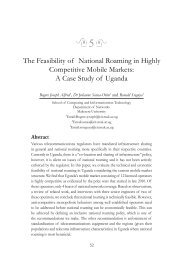Undergraduate Handbook - School of Computing and Informatics ...
Undergraduate Handbook - School of Computing and Informatics ...
Undergraduate Handbook - School of Computing and Informatics ...
You also want an ePaper? Increase the reach of your titles
YUMPU automatically turns print PDFs into web optimized ePapers that Google loves.
Indicative Content: The object oriented paradigm; Classes <strong>and</strong> objects; Inheritance <strong>and</strong> visibility modifiers;<br />
Interfaces <strong>and</strong> abstract classes; Graphical user interface <strong>and</strong> action h<strong>and</strong>lers; Exception h<strong>and</strong>ling; Working with<br />
files; Working with databases; Sessions <strong>and</strong> user management.<br />
Reference Books:<br />
i. M. R. Huth <strong>and</strong> M. D. Ryan, Logic in Computer Science, Modelling <strong>and</strong> Reasoning about Systems,<br />
Cambridge University Press, 2000.<br />
ii. SWI Prolog Home page, http://www.swi-prolog.org/<br />
CSC 1301: Practical Skills Development (4 CU)<br />
Course Content: The course aims at imparting practical skills in areas chosen by the faculty. The students are to be<br />
supervised by staff with in the faculty. Areas <strong>of</strong> practical skills development include; Implementation <strong>of</strong> projects;<br />
Network <strong>and</strong> system administration; Hardware maintenance <strong>and</strong> Computer assembly.<br />
This can be done within the Faculty <strong>of</strong> <strong>Computing</strong> <strong>and</strong> <strong>Informatics</strong> Technology or any other unit in Makerere<br />
University. Students will write a report at the end <strong>of</strong> the course.<br />
CSC 1303: Cisco Certified Network Associate (Audited) (5 CU)<br />
Course Content: In this course, students will cover the course content <strong>of</strong> the CCNA international curriculum.<br />
CSC 2100: Data Structures <strong>and</strong> Algorithms (4 CU)<br />
Course Description: Upon successful completion the students should be able to: Demonstrate factual knowledge<br />
including the mathematical notation, syntax <strong>and</strong> terminology used in the course; describe the fundamental principles<br />
including the laws <strong>and</strong> theorems arising from the concepts covered in this course; Apply course material along with<br />
techniques <strong>and</strong> procedures covered in this course to solve practical problems; Design simple algorithms <strong>and</strong> data<br />
structures in C <strong>and</strong> use theories <strong>and</strong> concepts covered in the course to approximate the complexities <strong>of</strong> algorithms.<br />
Indicative Content: Methods for modularizing, documenting <strong>and</strong> constructing Programmes (abstract data types/<br />
object orientation), <strong>and</strong> an introduction to classical data structures <strong>and</strong> algorithms with complexity analysis.<br />
Application <strong>and</strong> implementation <strong>of</strong> strings, arrays, stacks queues, lists, trees <strong>and</strong> graphs; Abstract data types; storage<br />
management; Sorting, searching, merging, reference <strong>and</strong> cross-referencing files; Design <strong>and</strong> analysis <strong>of</strong> algorithms,<br />
complexity <strong>of</strong> algorithms, big-O <strong>and</strong> small-O notation. Binary trees, B-trees, B*-trees, <strong>and</strong> AVL-trees; Study <strong>of</strong> disk<br />
<strong>and</strong> tape file organizations; Creation <strong>of</strong> sequential, direct, <strong>and</strong> indexed sequential files; Hashing techniques <strong>and</strong><br />
address overflows; Primary <strong>and</strong> secondary key usage, inverted <strong>and</strong> linked-list files; Semantic Nets, frames.<br />
Reference Books:<br />
i. A. V. Aho, J. D. Ullman, J. E. Hopcr<strong>of</strong>t, Data Structures <strong>and</strong> Algorithms, Addison-Wesley, 1983.<br />
ii. A. V. Aho, The Design <strong>and</strong> Analysis <strong>of</strong> Computer Algorithms, Addison-Wesley, Longman, 1974.<br />
iii. T. H. Cormen, C. E. Leiserson, R. L. Rivest, <strong>and</strong> C. Stein, Introduction to Algorithms, 2nd edition,<br />
McGraw-Hill, 2008.<br />
BSE 2105 Formal Methods (4 CU)<br />
Course Description: The course provides students with skills <strong>of</strong> solving generic formal problems in science. It<br />
covers the intellectual <strong>and</strong> practical skills necessary for problem formalization.<br />
Students will be provided with factual knowledge including the mathematical notations <strong>and</strong> terminologies used in<br />
formalizing scientific problems; fundamental principles including the laws <strong>and</strong> theorems arising from the concepts<br />
covered in this course; They will be able to apply course material along with techniques <strong>and</strong> procedures to solve<br />
practical problems; The course will provide them programming skills by writing numerical Programmes like Matlab<br />
Programmes, to solve numerical problems.<br />
31

















